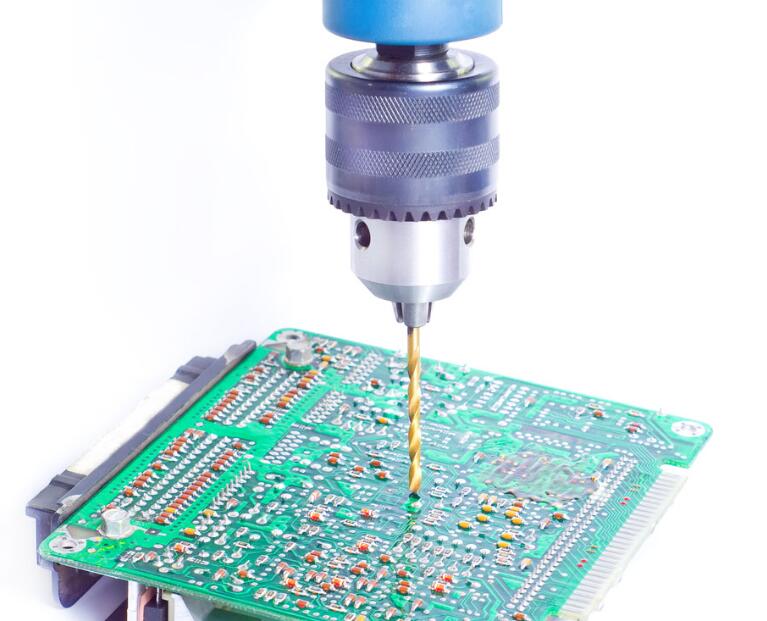Circuit board drills are used together with power tools to remove materials and create holes.PCB drill bits come in many sizes and shapes and can be used to manufacture different types of holes on many different materials. Soft materials can usually be safely drilled with almost any drill.

A pcb drill bites is very similar to a regular drill,except that it is optimized for drilling holes on printed circuit boards, rather than drilling holes on building materials such as metal and wood. Unlike other drills typically made of steel, circuit board drills are almost always made of tungsten due to their mechanical properties. The size of this type of drill varies greatly, but it is usually very small. This type of drill is sometimes used manually, but it is more often used in conjunction with drilling machines for automatic drilling. Circuit boards sometimes require holes to install parts or make them easier to adapt to certain systems.
To drill holes in the circuit board,engineers must first use an X-ray drill bit to locate the target points in the inner copper layer, to more easily determine the problems that need to be drilled on the board. Initially, the machine drilled holes for identification marks, allowing users to hit them later until the inner layer was centered.
Secondly, to set up a pcb drill, the panel is placed on a drilling machine to avoid tearing the copper foil when passing through the PCB board. Later, further PCB substrates were added to the drilling machine along with aluminum entering the foil. It provides users with many drill size options to drill holes on PCB boards according to their requirements.
Type
Drills for PCB drilling include straight shank Fried Dough Twists drill, fixed shank Fried Dough Twists drill and fixed shank spade drill.Straight handle Fried Dough Twists drills are mostly used for single head drilling machines to drill simple printed boards or single panels. Now they are rarely seen in large printed board manufacturers, and their drilling depth can reach 10 times the drill diameter. When the substrate layer is not high, using a drill sleeve can avoid drilling deviation. At present, most manufacturers use CNC drilling machines, which use fixed shank drill bits made of hard alloy and can achieve automatic replacement of drill bits. High positioning accuracy, no need to use drill sleeves. Large helix angle, fast chip removal speed, suitable for high-speed cutting. Within the full-length range of the chip removal groove, the diameter of the drill bit is an inverted cone, resulting in less friction with the hole wall during drilling and higher drilling quality. The common drill stem diameters are 3.00mm and 3.175mm.
Usage
pcb drill are mainly used for PCB manufacturing: printed circuit boards, which are made of several layers of resin material bonded together and internally wired with copper foil. There are 4, 6, and 8 layers. Drilling accounts for 30-40% of the cost of printed circuit boards, and mass production often requires specialized equipment and drills. A good pcb drill is made of high-quality hard alloy material, which has excellent characteristics such as high rigidity, high hole position accuracy, good hole wall quality, and long service life.
Characteristics
① Large chip removal space for drills: low chip removal resistance, smooth chip removal, low drilling heat generation, reducing drilling pollution;
② Exceptional cutting edge sharpness: Due to the use of nanotechnology and advanced grinding processes, the cutting edge of the drill bit is sharper than before, which can reduce cutting force, reduce drilling breakage rate, and improve hole wall quality;
③ Tool design based on customer applications: There are a variety of drill bits that can meet different application needs. All parameters of the drill bit, such as core thickness, core taper, etc., have been carefully designed, resulting in significant effectiveness;
④ The cutting edge is strictly symmetrical: it is conducive to efficient cutting and avoids drilling deviation.
Difference between circuit board drill and Fried Dough Twists drill
The difference lies in the different types, shapes, purposes, and processing methods.
1. Different types: PCB drills are mainly used to drill holes for circuit boards with small diameters and high precision, while Fried Dough Twists drills are mainly used to drill metal materials and plastic materials with large diameters and deep processing depth.
2. Different shapes: circuit board drills are relatively slender, usually cylindrical or conical, and can be used for high speed and high-precision positioning and drilling processing; The Fried Dough Twists drill is relatively coarse and short, usually spiral, and can be used for deep hole machining and rough machining.
3. Different purposes: pcb drill are mainly used for drilling and conducting, that is, connecting various circuits, while Fried Dough Twists drills are mainly used for making threaded holes, assembly holes, through holes, etc.
4. Different processing methods: pcb drill generally use high-speed and high-precision rotary processing, while Fried Dough Twists drills use a composite processing method of rotation and feed, which can carry out high speed, efficient and high-precision drilling.
The core goal of a circuit board drill is to drill precise holes in fiberglass-printed circuit boards, plastics, and other laminates.PCB drills are micro drills, to provide as much drilling accuracy as possible. Despite being exposed to high temperatures and wear, pcb drill bits can still provide sufficient rigidity and longer tool life. Usually, have a diameter equal to the shank diameter to achieve smooth and burr-free performance.